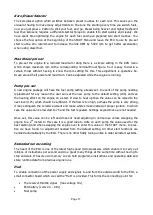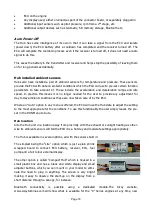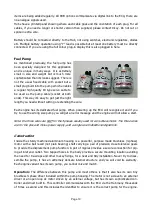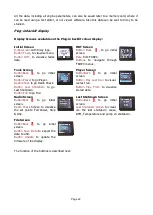
Page 8
General Notes
This engine is a real gas turbine machine with very high rotational speeds and high temperature
fast moving exhaust. Despite the small intake the engine is able to swallow a huge amount of air
and anything else that air can carry with it. So before running please carefully check the area sur-
rounding the front and back end of the engine for any loose materials like rags, sawdust, sand or
grit, modelling materials, liquids, or anything else that can be picked up by the airstream and
sucked into the engine, or blown out at speed by the exhaust.
If you are new to turbines or returning after some years it is a good idea to set up the engine on a
simple test stand so you can get familiar with its operation before installing it into a model. Use a
maximum thrust setting that is appropriate for your model especially on 1
st
flights. The RUN menu
shows this clearly, see “
derating
”. A power/weight ratio of 1:1 sounds great but can accelerate a
model dangerously quickly and can lead to control or structural failure of the model. If you have
recent jet engine experience you should be able to install the engine straight into your model but
take careful note of the quick response in start-up and throttling. Every engine is carefully test run
at the factory to ensure it performs properly, so you can take confidence to know it is fully opera-
tional at time of despatch.
Being an internal combustion engine the engine will consume oxygen during running so must nev-
er be run inside or in a confined space. The engine consumes a volume of air about 20ltrs/.74cu.ft
FOR EVERY KG OF THRUST every SECOND (ie, 4.5kg = a dustbin full) so can quickly use up a lot
of air in a limited space, so only run outside in open air. Never try to slow the engine by placing
any kind of restriction on the intake or the exhaust or on the model. The suction is more powerful
than any vacuum cleaner and can do severe damage to anything passing into the intake. It can
also collapse an airframe where insufficient area for the intake air is provided, or is restricted in
some way. The fod screen supplied is intended to prevent small articles being drawn into the en-
gine like blades of grass, small stones etc. It cannot prevent a rag or similar being accidentally
jammed against the front of the engine by the suction, so please take great care. Never test the
suction with fingers or hand, these engines bite hard.
The engine exhaust exit is small but with such a large volume of gas passing through it at pres-
sure it makes a loud penetrating noise. At a distance this noise is most pleasing but in close prox-
imity (within 5mtrs/16ft) the noise level can be very hazardous to hearing so always ensure you
and any nearby helpers have proper ear defenders and are wearing them while test running the
engine. Ensure you check carefully the area where you plan to run the engine and have someone
keep lookout for inquisitive bystanders who could approach to see the source of the noise, as you
will be concentrating on the engine. Agree a system of hand signals in advance so they know what
you are planning to do and can warn you of any issue during the run, i.e. shut down in a hurry or
reduce to idle if someone (or an animal) is approaching, walking by, etc.
The engine has its own internal starting system and does not require any assistance or priming to
operate. So please do not try to assist it to start quicker or easier by administering any flammable
agents, sprays or similar, into the engine in the belief it will start better. It won´t, but it could re-
sult in causing a dangerous flashback or fire to start which could rapidly get out of control and
putting yourself in danger or more surely the destruction of your model. The engine
does not









































